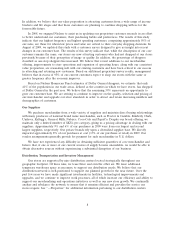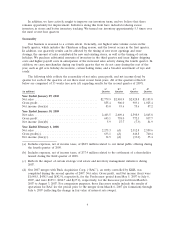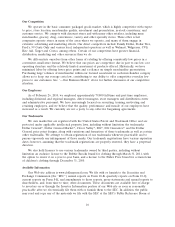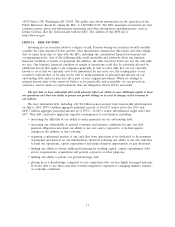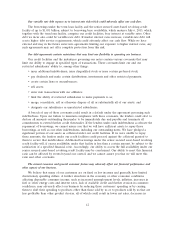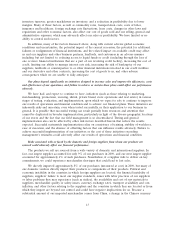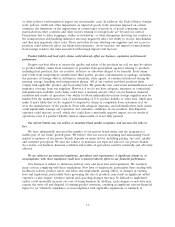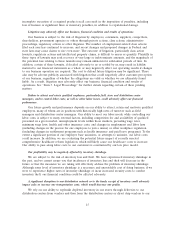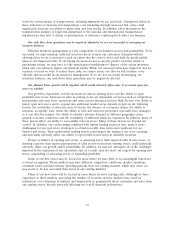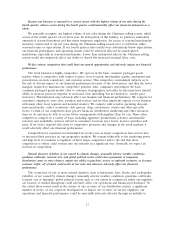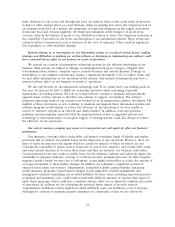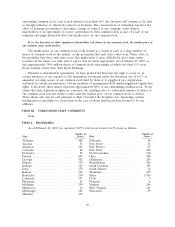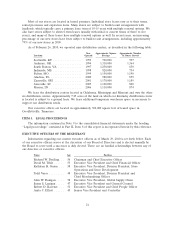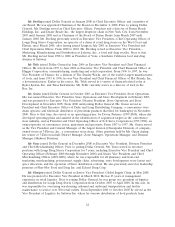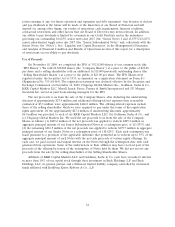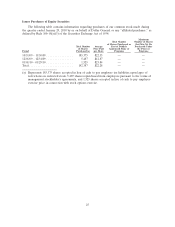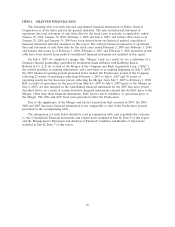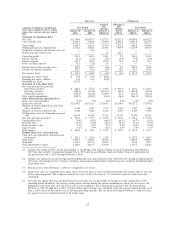Dollar General 2009 Annual Report Download - page 29
Download and view the complete annual report
Please find page 29 of the 2009 Dollar General annual report below. You can navigate through the pages in the report by either clicking on the pages listed below, or by using the keyword search tool below to find specific information within the annual report.make deliveries to our stores and through lost sales. In addition, these events could result in increases
in fuel (or other energy) prices or a fuel shortage, delays in opening new stores, the temporary lack of
an adequate work force in a market, the temporary or long-term disruption in the supply of products
from some local and overseas suppliers, the temporary disruption in the transport of goods from
overseas, delay in the delivery of goods to our distribution centers or stores, the temporary reduction in
the availability of products in our stores and disruption to our information systems. These events also
can have indirect consequences such as increases in the costs of insurance if they result in significant
loss of property or other insurable damage.
Material damage to, or interruptions to, our information systems as a result of external factors, staffing
shortages and difficulties in updating our existing software or developing or implementing new software could
have a material adverse effect on our business or results of operations.
We depend on a variety of information technology systems for the efficient functioning of our
business. Such systems are subject to damage or interruption from power outages, computer and
telecommunications failures, computer viruses, security breaches and natural disasters. Damage or
interruption to our computer systems may require a significant investment to fix or replace them, and
we may suffer interruptions in our operations in the interim. Any material interruptions may have a
material adverse effect on our business or results of operations.
We also rely heavily on our information technology staff. If we cannot meet our staffing needs in
this area, we may not be able to fulfill our technology initiatives while continuing to provide
maintenance on existing systems. We rely on certain software vendors to maintain and periodically
upgrade many of these systems so that they can continue to support our business. The software
programs supporting many of our systems were licensed to us by independent software developers. The
inability of these developers or us to continue to maintain and upgrade these information systems and
software programs would disrupt or reduce the efficiency of our operations if we were unable to
convert to alternate systems in an efficient and timely manner. In addition, costs and potential
problems and interruptions associated with the implementation of new or upgraded systems and
technology or with maintenance or adequate support of existing systems could also disrupt or reduce
the efficiency of our operations.
Our current insurance program may expose us to unexpected costs and negatively affect our financial
performance.
Our insurance coverage reflects deductibles, self-insured retentions, limits of liability and similar
provisions that we believe are prudent based on the dispersion of our operations. However, there are
types of losses we may incur but against which we cannot be insured or which we believe are not
economically reasonable to insure, such as losses due to acts of war, employee and certain other crime
and some natural disasters. If we incur these losses and they are material, our business could suffer.
Certain material events may result in sizable losses for the insurance industry and adversely impact the
availability of adequate insurance coverage or result in excessive premium increases. To offset negative
insurance market trends, we may elect to self-insure, accept higher deductibles or reduce the amount of
coverage in response to these market changes. In addition, we self-insure a significant portion of
expected losses under our workers’ compensation, automobile liability, general liability and group
health insurance programs. Unanticipated changes in any applicable actuarial assumptions and
management estimates underlying our recorded liabilities for these losses, including expected increases
in medical and indemnity costs, could result in materially different amounts of expense than expected
under these programs, which could have a material adverse effect on our financial condition and results
of operations. In addition, we are evaluating the potential future impact of recently enacted
comprehensive healthcare reform legislation, which will likely cause our healthcare costs to increase.
Although we continue to maintain property insurance for catastrophic events, we are effectively
18


